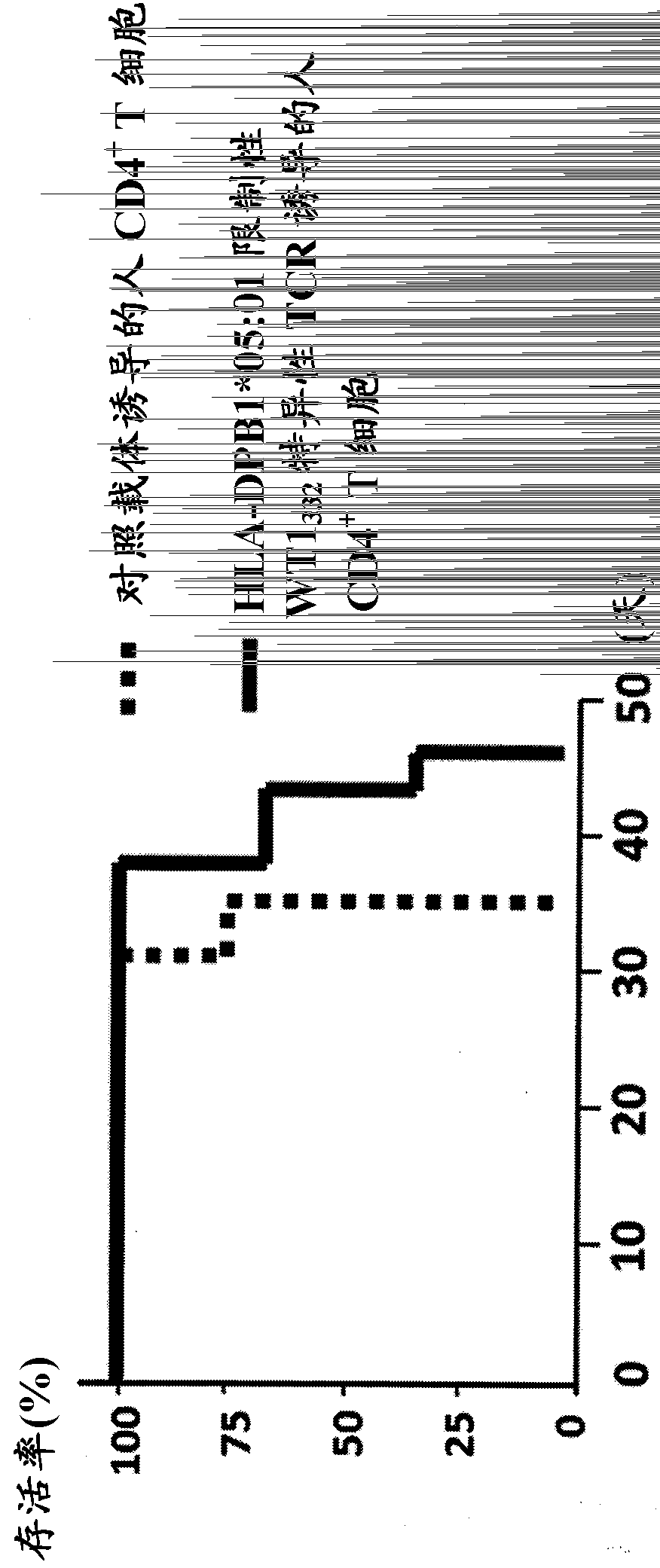antigen-specific helper t cell receptor gene
An auxiliary and specific technology, applied in the field of polynucleotides, can solve the problem of not knowing the specificity of the identification of auxiliary peptide antigens, and achieve the effect of treating or preventing cancer
- Summary
- Abstract
- Description
- Claims
- Application Information
AI Technical Summary
Problems solved by technology
Method used
Image
Examples
Embodiment 1
[0167] Example 1. WT1 332 specific CD4 + Establishment of T cell clones and isolation and sequencing of T cell receptor (TCR) genes
[0168] The experimental steps are as follows.
[0169] (1) Create WT1 332 specific CD4 + Methods of T cell cloning
[0170] (i) Harvest peripheral blood mononuclear cells (PBMCs) from healthy subjects at 3x10 6 cells / well were seeded into a 24-well plate. X-VIVO 15 medium supplemented with 10% AB serum and 40 IU / ml IL-2 was used as the medium.
[0171] (ii) Add WT1 at a final concentration of 20 µg / ml 332 Peptides were added to i above and cells were cultured for 7 days.
[0172] (iii) After 7 days, the cells were collected and prepared with X-VIVO 15 medium supplemented with 10% AB serum to make the cell density 1x10 7 cells / ml, and 100 μL of each was seeded into a 96-well round-bottom plate.
[0173] (iv) At final concentrations of 40 µg / ml, 4 µg / ml and 4 µg / ml, WT1 332 Peptides, BD GolgiStopTM (BD Bioscience) and CD28 / CD49d Costi...
Embodiment 2
[0225] Example 2. Will be derived from WT1 332 specific CD4 + T cell receptor (TCR) gene of T cell into human CD4 + in T cells
[0226] confirmed the use of WT1-derived 332 specific CD4 + Human CD4 transduced with T cell receptor (TCR) gene for T cells + WT1 332 Specific and HLA class II-restricted manner displays proliferative responses and produces cytokines.
[0227] The TCR genes shown in Table 3 were isolated from clone 9, which specifically recognized WT1 in a HLA-DPB1*05:01 restricted manner 332 CD4 + T cell cloning. By using lentiviral vectors, these TCR genes were transduced into CD4 cells derived from the peripheral blood of healthy subjects. + T cells, and by using cytokine (interferon-γ and IL-2) production as indicators, the response to WT1 332 Reaction( Figure 2A and B). In addition, CD4 transduced with a lentiviral vector that does not carry the TCR gene +T cells (labeled mock) were used as controls. use WT1 332 CD4-specific TCR gene transd...
Embodiment 3
[0235] Example 3. By using the source from WT1 332 specific CD4 + Human CD4 transduced with TCR gene of T cells + T cells enhance the induction of WT1-specific CTL
[0236] In general, it is known that CD4 + T cells serve as helper T cells and respond to CD8 as primary effector cells attacking cancer cells + Introduction and maintenance of T cells (CTL) are important. Therefore, WT1 was analyzed 332 -TCR-transduced CD4 + Whether T cells enhance the induction of WT1-specific CTLs.
[0237] PBMCs from HLA-A*24:02 and HLA-DPB1*05:01-positive healthy subjects were compared with WT1 prepared from the same healthy subjects 332 -TCR-transduced CD4 + T cells were mixed at a ratio of 10:1 and 5:1 (labeled 1:0.1 and 1:0.2 in Figure 3) and incubated in modified WT1 235 Incubate for 1 week in the presence of peptide (wherein M, the second amino acid of natural WT1 peptide combined with HLA-A*24:02 molecule, is modified into Y (CYTWNQMNL) (SEQ ID No: 125)), the modified WT1...
PUM
 Login to View More
Login to View More Abstract
Description
Claims
Application Information
 Login to View More
Login to View More - Generate Ideas
- Intellectual Property
- Life Sciences
- Materials
- Tech Scout
- Unparalleled Data Quality
- Higher Quality Content
- 60% Fewer Hallucinations
Browse by: Latest US Patents, China's latest patents, Technical Efficacy Thesaurus, Application Domain, Technology Topic, Popular Technical Reports.
© 2025 PatSnap. All rights reserved.Legal|Privacy policy|Modern Slavery Act Transparency Statement|Sitemap|About US| Contact US: help@patsnap.com



